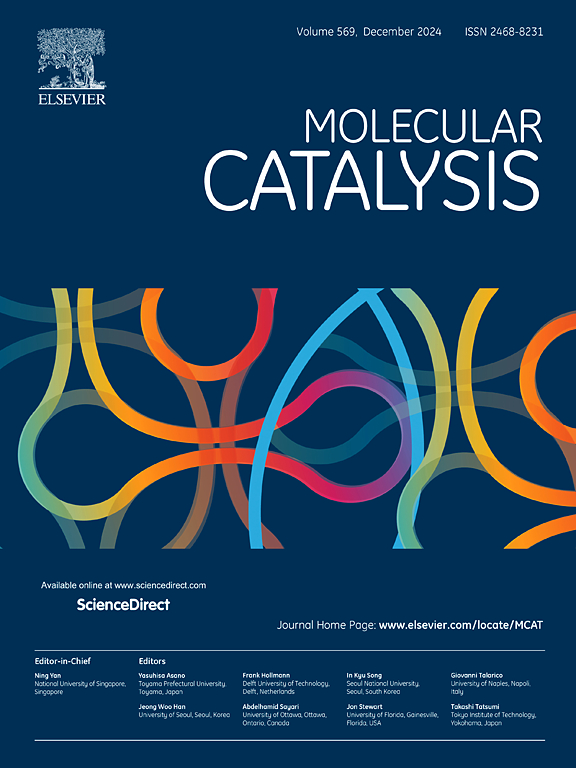CTAB 辅助射频放电等离子体处理提高了镍基催化剂的催化活性,使其在二氧化碳/CH4 重整反应中具有持续的抗结焦性
IF 3.9
2区 化学
Q2 CHEMISTRY, PHYSICAL
引用次数: 0
摘要
在甲烷干转化反应(DRM)过程中,碳沉积或 "结焦 "反应严重抑制了催化剂的活性。采用传统浸渍法制备的 MCM-41 负载镍催化剂 (NM-C) 也面临这些问题。为此,本研究采用 N2 射频 (RF) 放电等离子与表面活性剂(十六烷基三甲基溴化铵或 CTAB)改性相结合的新型催化剂制备方法。利用 XRD、H2-TPR、CO2-TPD、TEM、XPS、TG-DTA 和其他分析技术对所得材料进行了表征。实验结果表明,添加 CTAB(NM-CTAB-C)和等离子体辅助催化剂制备(NM-PN2h)在 DRM 中的性能均优于传统的 NM-C 催化剂。值得注意的是,采用 CTAB 辅助等离子体法制备的催化剂(NM-CTAB-PN2h)性能显著提高,在 700 °C 时,CH4 和 CO2 的初始转化率分别为 84.82% 和 85.02%。与 NM-C 相比,NM-CTAB-PN2h 的 CH4 和 CO2 转化率分别提高了 24.8% 和 19.9%。NM-CTAB-PN2h 的镍晶粒尺寸(4.9 nm)明显小于 NM-C(18 nm),这表明它在二氧化碳和甲烷干转化过程中具有更强的抗结焦性和稳定性。反应 20 小时后,NM-CTAB-PN2h 的粒径保持在 6.3 纳米,明显小于 NM-C(21.4 纳米)。此外,NM-CTAB-PN2h 还具有显著的抗积碳能力,在 700 °C 下反应 20 小时后,其重量损失仅为 2.36%,而 NM-C 则为 23.38%。利用 CTAB 辅助等离子体可减小镍晶粒尺寸,增强金属与支撑物之间的相互作用,并增加氧空位,从而提高干重整性能。本文章由计算机程序翻译,如有差异,请以英文原文为准。
CTAB-assisted radio frequency discharge plasma treatment enhances catalytic activity at sustained coking resistance of Nickel-based catalysts for CO2/CH4 reforming reaction
Carbon deposition or ‘coking’ reaction severely suppresses catalyst activity during the dry reforming reaction of methane (DRM). The MCM-41-loaded nickel catalyst (NM-C) prepared using the conventional impregnation method also faces these issues. In response, this study investigates a novel catalyst preparation approach employing N2 radio frequency (RF) discharge plasma coupled with surfactant (cetyltrimethylammonium bromide or CTAB) modification. Characterization of the resulting materials was conducted utilizing XRD, H2-TPR, CO2-TPD, TEM, XPS, TG-DTA, and other analytical techniques. Experimental findings reveal that both CTAB addition (NM-CTAB-C) and plasma-assisted catalyst preparation (NM-PN2h) outperform the conventional NM-C catalyst in the DRM. Notably, the catalyst prepared by the CTAB-assisted plasma method (NM-CTAB-PN2h) demonstrates significantly enhanced performance, with initial CH4 and CO2 conversions of 84.82% and 85.02%, respectively, at 700 °C. Compared to NM-C, NM-CTAB-PN2h exhibits improvements of 24.8% and 19.9% in CH4 and CO2 conversions, respectively. The Ni grain size of NM-CTAB-PN2h (4.9 nm) is notably smaller than NM-C (18 nm), indicating enhanced resistance to coking and stability during CO2 and methane dry reforming. After 20 h of reaction, NM-CTAB-PN2h maintains a particle size of 6.3 nm, significantly smaller than NM-C (21.4 nm). Moreover, NM-CTAB-PN2h exhibits remarkable resistance to carbon accumulation, with only a 2.36% weight loss compared to 23.38% for NM-C after 20 h at 700 °C. Utilization of CTAB-assisted plasma reduces Ni grain size, enhances metal-support interaction, and increases oxygen vacancies, thus improving dry reforming performance.
求助全文
通过发布文献求助,成功后即可免费获取论文全文。
去求助
来源期刊

Molecular Catalysis
Chemical Engineering-Process Chemistry and Technology
CiteScore
6.90
自引率
10.90%
发文量
700
审稿时长
40 days
期刊介绍:
Molecular Catalysis publishes full papers that are original, rigorous, and scholarly contributions examining the molecular and atomic aspects of catalytic activation and reaction mechanisms. The fields covered are:
Heterogeneous catalysis including immobilized molecular catalysts
Homogeneous catalysis including organocatalysis, organometallic catalysis and biocatalysis
Photo- and electrochemistry
Theoretical aspects of catalysis analyzed by computational methods
 求助内容:
求助内容: 应助结果提醒方式:
应助结果提醒方式:


